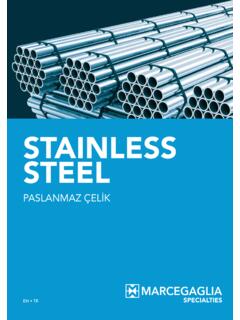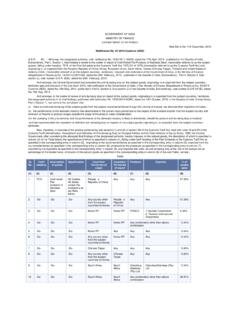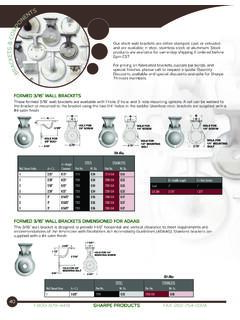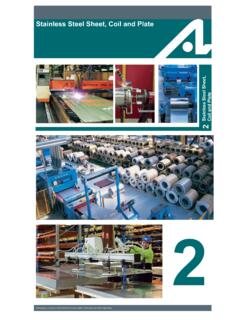Transcription of Bilateral safeguard measures - Jindal Stainless
1 14200 December 2014 / Outlook BUSINESS Outlook BUSINESS / 00 December The rise in imports of Stainless steel flat products has caused aggressive price under cutting. What is the way out for the industry?On account of slump in demand there is an over capacity in Stainless steel globally, especially in China. The manner in which China has increased its capacity in the past decade is mind boggling. The global Stainless steel production is around 35 million tons out which China alone has a capacity of over 19 million tons. Japan is number two with just 3 million tons and we are number three at million tons. This has created a situation of dumping and price under cutting, as every Stainless steel producing nation is sitting on over capacities.
2 While originally the imports started with Coils followed by Circles and now even Tubes & Pipes have started to come in from Vietnam and some other countries. Today more and more capacities are coming up for tubes and pipes in countries such as Indonesia, Malaysia and Taiwan, implying that we can expect more dumping to happen in India in days to come. The Government needs to recognize this imbalance in trade and since there are adequate capacities in India, suitable measures need to be taken for healthy competitive Imports of raw materials from China and other countries are hitting foreign exchange, what else could be done for indigenous supply of raw material?Essential raw materials like nickel ore and molybdenum ore are not found in India and as such these have to be compulsorily imported.
3 As regards steel scrap and Stainless steel scrap, the domestic supply is enough to meet only a small portion of the total demand. One has to understand that the steel industry and in particular the Stainless steel industry in India is a fairly young industry and considering the overall life cycle of Stainless steel , the level of scrap generation is a long way off from attaining the desired levels. However, as pointed out earlier, suitable fiscal incentives like 2. 5 % duty on inputs needs to be reversed back to zero. For items like iron ore and chrome ore which are available within the country , it is important to undertake mining sector reforms in order to create raw material security and completely do away with the need for importing items like Ferro Which sectors are at the forefront of adopting Stainless steel ?
4 Traditionally, Stainless steel has found acceptance and usage in the following sectors: Kitchenware, Tableware, Nuclear Power, Petrochemical, Process Industries, Automotive, Railway and Transportation and Architecture, Building and Construction. Having realized the great value Stainless steel brings to the table, more and more sectors are now openly experimenting with Stainless steel such as, mints, plumbing, overhead water tanks, modular kitchens, modular toilets, milk cans, solar power, gas cylinder etc. What do you expect from the government on the policy front?We expect policy overhaul in the mining sector to ensure availability of critical raw materials to genuine users.
5 There are instances where genuine users of metal who are into value addition are deprived of the raw minerals, while one the other hand few miners have been exporting raw minerals without any value addition. Hence, government policy should support players who are adding value to mineral as per the mineral development guidelines in the MMDR Act. Lowering of import duties to zero, is essential on critical inputs like Ferro nickel, pure nickel and SS Scrap to make the domestic industry competitive and place it at par with the Chinese Stainless steel industry which enjoys zero import duty on inputs. Moreover, the import duty on finished Stainless steel should be hiked from to 10% to adequately support the domestic industry.
6 Further, the duty on finished Stainless steel in India is only % as compared to our competitor countries like Brazil and China having 14% and 10% respectively. This disparity in duty rates needs to be immediately addressed by the government to make Indian Stainless steel industry competitive. Making BIS standards mandatory for all Stainless steel flat products should be encouraged by the government in order to ensure only quality products are produced and only quality products come into the country. Also as a result of the existing FTA s with Korea, Japan and ASEAN countries , import duties have already come down to nil or will come to nil over the next 2 years.
7 This has resulted in an import glut from these countries. These tariff concessions need to be reversed, and if that is not possible, then government should introduce Bilateral safeguard measures to counter the negative impact of FTA s on domestic a greater threat currently looms over the industry in form of RCEP of which China would also be a part. As it is imports from China have grown over 700% over the past 5 years and if Stainless steel is not kept in the negative list during the RCEP negotiations it will spill death knell for the Indian Stainless steel Industry. Bilateral safeguard measures : Is the need of the hour to counter negative impact of FTA s on domestic industryMaking BIS standards mandatory for all Stainless steel flat products should be encouraged by the government in order to ensure only quality products are produced and only quality products come into the Rajiv Rajvanshi, Senior Vice PresidentCorporate Strategy, Jindal Stainless ltdJajpur Plant, Odisha14200 December 2014 / Outlook BUSINESS Outlook BUSINESS / 00 December The rise in imports of Stainless steel flat products has caused aggressive price under cutting.
8 What is the way out for the industry?On account of slump in demand there is an over capacity in Stainless steel globally, especially in China. The manner in which China has increased its capacity in the past decade is mind boggling. The global Stainless steel production is around 35 million tons out which China alone has a capacity of over 19 million tons. Japan is number two with just 3 million tons and we are number three at million tons. This has created a situation of dumping and price under cutting, as every Stainless steel producing nation is sitting on over capacities. While originally the imports started with Coils followed by Circles and now even Tubes & Pipes have started to come in from Vietnam and some other countries.
9 Today more and more capacities are coming up for tubes and pipes in countries such as Indonesia, Malaysia and Taiwan, implying that we can expect more dumping to happen in India in days to come. The Government needs to recognize this imbalance in trade and since there are adequate capacities in India, suitable measures need to be taken for healthy competitive Imports of raw materials from China and other countries are hitting foreign exchange, what else could be done for indigenous supply of raw material?Essential raw materials like nickel ore and molybdenum ore are not found in India and as such these have to be compulsorily imported. As regards steel scrap and Stainless steel scrap, the domestic supply is enough to meet only a small portion of the total demand.
10 One has to understand that the steel industry and in particular the Stainless steel industry in India is a fairly young industry and considering the overall life cycle of Stainless steel , the level of scrap generation is a long way off from attaining the desired levels. However, as pointed out earlier, suitable fiscal incentives like 2. 5 % duty on inputs needs to be reversed back to zero. For items like iron ore and chrome ore which are available within the country , it is important to undertake mining sector reforms in order to create raw material security and completely do away with the need for importing items like Ferro Which sectors are at the forefront of adopting Stainless steel ?









